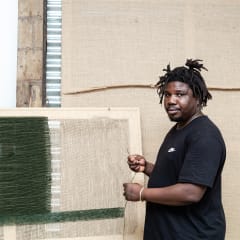Alvaro Barrington & Chico da Silva Alvaro Barrington & Chico da Silva
Click here to book your visit.
Mendes Wood DM is pleased to present Alvaro Barrington & Chico da Silva, an exhibition that places renowned Venezuelan-born contemporary artist Alvaro Barrington (b. 1983) in dialogue with the works of Chico da Silva (1910 – 1985), a Brazilian artist of Ashaninka origin, an indigenous group located in the Peruvian Amazon. Despite temporal and spatial distances, meaningful connections between the artists reveal themselves through technical characteristics – such as chromatic vibration, gesturality, and their use of unconventional materials – and, above all, through their shared commitment to representing culturally heterogeneous communities.
During a visit to Brazil for the opening of his first solo exhibition at Mendes Wood DM in 2023, Alvaro Barrington came across the self-taught artist’s drawings. Inspired by the fantastical and vivid nature of da Silva’s works, Barrington created five paintings of fish that will be presented for the first time alongside works by da Silva – this at a moment in Barrington’s career when depicting fish has become important to the artist. His drawings of marine life, oscillating between bold and subtle brushstrokes, evoke a sensation of constant movement. Alternating with celebrated drawings by Chico da Silva, including Fishes and Fish and octopus (1966), the exhibition invites the public to immerse themselves in a brilliant, dynamic ocean.
Alvaro Barrington is well known for engaging in exuberant productions that play with influences from a wide array of artists. Born in Venezuela to a Haitian father and a Grenadian mother, Barrington, who currently resides in East London, was raised in the Caribbean and later in Brooklyn. For him, painting is the foundation of a practice that encompasses installation, sculpture, found objects, textiles, the written word, and community gatherings.
Chico da Silva’s canvases, which precipitated this exhibition, are inhabited by spirited creatures in scenes packed with motion, marked by rich coloration. Seabed (1963) – a magnificent painting executed on wood, featuring a solid color background with edge treatment created through finger impressions – depicts colorful sea creatures positioned centrally, evoking a sense of movement. Both artists share a reliance on corporeality, often incorporating bodily impressions onto their works’ surfaces.
Committed to their respective heterogeneous communities and ancestries, their creations carry narratives outside the canon of art history, with a concern for reimagining how traditions are honored and defined. On the one hand, da Silva presents Brazilian folklore on walls and canvases, bringing elements of popular imagination and promoting identification and belonging. On the other hand, London-based Barrington reclaims ancestry in his installations, evoking themes from African-diasporic communities and his personal experiences.
In 1943, while still an outsider artist, Chico da Silva met the Swiss art critic and artist Jean-Pierre Chabloz, who had immigrated to Brazil. The encounter was highly significant in the diffusion of the artist’s work, which, circulated throughout Brazil and Europe, becoming one of the first artists of indigenous origin to be recognized internationally. His work was included in the 33rd Venice Biennale in 1966 and the 9th São Paulo Art Biennial the following year. It is currently being revisited with new readings and interpretations. Currently, Álvaro Barrington is presenting the large-scale installation GRACE at Tate Britain. Despite differences in their trajectories, the depth of shared narratives creates a fertile space for reflection on art as a means of connection, memory, and resistance.

